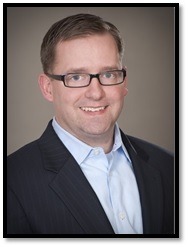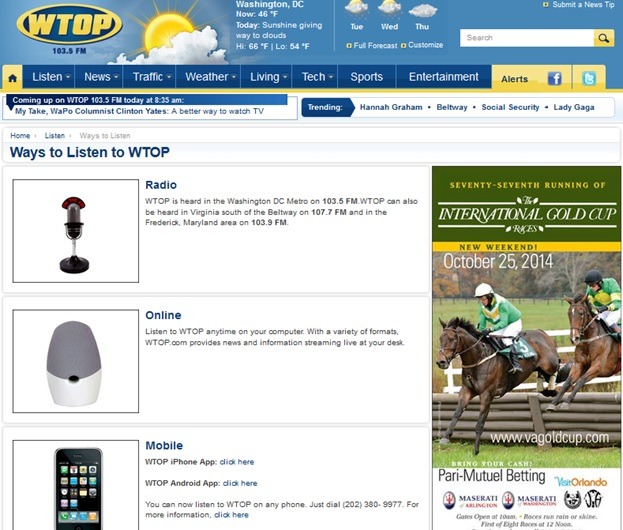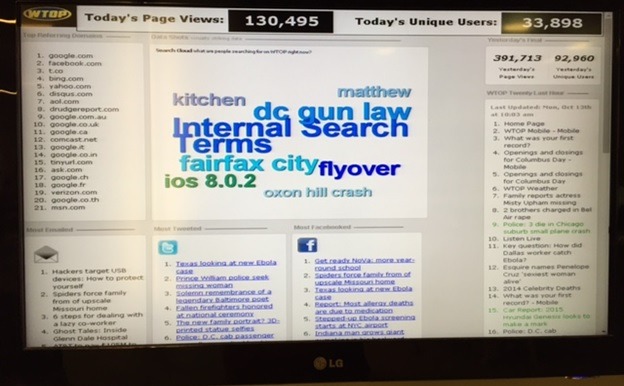
There are many factors that have contributed to Hubbard Radio’s All-News WTOP in Washington, D.C., being the top billing station in the United States for the last four years running. They were one of the first News/Talk stations to make the leap to FM, which significantly improved their market coverage, and in turn, the ratings. WTOP also excels at understanding the essence of their market. Their focus on the federal government and the area’s heinous traffic problems go to the heart of their connection with their local audience.
From top to bottom, WTOP is staffed with a group of professionals who are laser-focused on building an amazing media brand. From their manager Joel Oxley to programmers like Jim Farley and Laurie Cantillo, WTOP’s staff is at the top of its game in information delivery, serving its listeners, advertisers, and its expanding community.
 Today’s honor is focused on the commitment they’ve made to their digital properties, an important part of the WTOP brand that is truly cutting edge. With support from their parent company, WTOP is playing a long game, investing wisely in their digital resources to help serve an ever-changing audience.
Today’s honor is focused on the commitment they’ve made to their digital properties, an important part of the WTOP brand that is truly cutting edge. With support from their parent company, WTOP is playing a long game, investing wisely in their digital resources to help serve an ever-changing audience.
In an announcement that the station was once again the nation’s top radio revenue producer last year, Mark Fratrik, SVP/Chief Economist for BIA/Kelsey, said, “WTOP is morphing into a digital media company by providing access to its audience in many different ways beyond over-the-air. Their approach is serving them well and their model demonstrates that as the industry continues to adopt a multi-platform approach, it will engage audiences and sustain growth.”
For this week’s edition of Radio’s Most Innovative, we spoke to John Meyer, WTOP’s director of Digital Media, who shared his insights on what this media brand is doing differently from other radio stations in the format, and how those efforts have paid off.
Jacobs Media: WTOP is more than just a transmitter and tower. What is the vision for satisfying the D.C. area’s need for information?
John Meyer: People don’t fall in love with distribution platforms, they connect with brands. It’s all about great content. Our vision is to continue to build on the success of WTOP and be the number one NEWS brand in the D.C. region. While radio is – and will continue to be – a key component of our strategy, we aspire to be the news leader on ALL platforms in traditional and new media. WTOP competes with local television, digital news sites, and the Washington Post.
JM: In a world where traffic, school closings, news headlines and other information are becoming on-demand, how does WTOP use innovation to adapt?
Meyer: It’s all about the “value add.” Sure, you can get much (not all) of that information from other sources. What WTOP brings is credibility and trust, speed, analysis, and detail. We have newsmakers and A-list guests on consistently who break down and advance our top stories. We challenge our reporters to produce more exclusive content, so our competitors follow US. We need to continue to find ways to de-commoditize information.
JM: Thinking about what WTOP was just a decade ago. What is an innovation that has really transformed the brand?
Meyer: Our commitment to and investment in digital. WTOP got on board early, not because digital was the shiny, new thing, but because it makes good business sense for us. We now have 15 people dedicated to content for WTOP.com and traffic has grown accordingly.
JM: What’s the most innovative thing you’re doing on the digital front?
Meyer: Innovation can be a bit of a trap. We are careful not to do things just because we can or because they are cool. What we do isn’t necessarily sexy. You don’t read a lot of stories about how organizations are using text to build their business. But people still appreciate good storytelling on the web. We focus a lot on original digital content.
Infrastructure is another area in which WTOP is innovative (also not particularly sexy.) In order to compete in the digital space, you need to have experienced writers and editors. We don’t necessarily look to hire broadcasters as much as we look for good writers. We look to the digital and print world when we hire now.
JM: How is WTOP.com different from other radio station websites?
Meyer: We don’t think of ourselves as a radio station website. Digital provides a great opportunity for us to expand our news brand beyond the car. WTOP can now be a news source on the phone, desktop, and tablet. In order to be credible in this arena, it takes resources. We have dedicated significant resources in the form of people and technology to create a viable digital product. We have a focused strategy on building digital traffic and driving page views. This, in turn, feeds our business model, which is primarily display advertising.
JM: Can you share some stats on your website traffic?
Meyer: WTOP.com receives around 20 million page views per month and is visited by over 2 million monthly unique users. About 40% of our traffic is mobile (including tablet.)
JM: What are some of the things you’ve done to drive that sort of traffic?
Meyer: We have three primary tenets of our traffic strategy:
1. Create and maximize quality original content.
2. Maximize the side door. We have very specific goals for traffic driven from Facebook and Twitter.
3. Use metrics to maximize the performance of our homepage.
JM: Can you expand on how you use metrics to maximize performance? What numbers do you look at and can you explain how the site’s schedule of five “editions” works?
Meyer: We operate our website on a more traditional print model. We publish editions throughout the day. While we constantly post timely or breaking news on our site, we have five benchmark times throughout the day when we have editorial meetings. During these meetings we take a closer look at how the site is performing, what new stories are developing, and we check the overall balance of the site.
From a metrics standpoint, we have tools that will tell us how every position on our homepage is performing. When we see a story that’s not performing well, we will either move it, tweak the headline, or possibly rotate it off the site. While we don’t make decisions strictly on the metrics, they are a good guideline as we make editorial decisions and maximize the performance of our site.
JM: Which way does content flow most often: from the website to the air or from the air to the website?
Meyer: A large part of our content still originates from broadcast stories. However, we have recently hired four new section editors (entertainment, living, sports, and tech). They are primarily responsible for writing an original story for the website each day and also to provide audio content for radio. We are finding that it is generally easier to take a longer piece and condense it for broadcast than to take short copy and add detail.
JM: With the website and station acting independently, what is your overall strategy for utilizing social media?
Meyer: I wouldn’t say that we act completely independently. Our digital and broadcast editors sit next to each other and are in constant communication. In terms of social media, we primarily use Facebook and Twitter. Facebook is used to drive traffic to our website. We are posting throughout the day. Our Twitter strategy is a bit different. We definitely use it to promote our stories. But also to promote things we have coming up on the radio station, with a link to listen live. In a breaking news situation, we use Twitter to plant our flag in a story. We will go to Twitter and send mobile alerts before we go on-air or online.
JM: Traffic is a big part of the WTOP brand. How has it been adapted for digital?
Meyer: We are currently in the process of developing some new digital traffic offerings that will be available in early 2015. Stay tuned.
JM: Are your investments paying off? Are your digital efforts profitable?
Meyer: Yes. We have always been very focused on our business model and continue to adjust to maximize its profitability.
JM: What was the biggest challenge you faced on the digital side of the operation and how did you overcome it?
Meyer: I think the biggest challenge we had was the ability to support our growth. We had some major security and reliability issues on the technical side of our business. It really opened our eyes to the importance of infrastructure. Technology is the core of our distribution and needs to be handled more strategically. We are in the process of overhauling our entire technical backend system. We’re looking at technology on the same level as content or marketing by trying to be more proactive and strategic with how we use it.
JM: What’s one thing that’s failed?
Meyer: A few years ago we invested pretty heavily in video. The problem was that we were doing video for the sake of doing video. People don’t come to a website because they want to watch video. They come because they want to watch a sports highlight or an episode of The Wire. We weren’t very good at video and no one consumed it. Now we use video more organically, if it enhances or elevates a story.
JM: What advice do you have for someone who has an innovative idea but doesn’t know where to begin trying to make it happen?
Meyer: Follow the money. Who could financially benefit from the idea? What is the business model behind the idea?
Thanks to Mike Stern for writing this week’s RMI.
INNOVATION QUOTE OF THE WEEK
“Innovation is not about one person. Steve Jobs and Bill Gates had great teams around them.”
Gary Shapiro, President/CEO Consumer Electronics Association at DASH 2014
Check out some of our “Past Innovators” here:
- September 26 John Fullam/Greater Media Philly Innovation Challenge
- October 3 Norm Pattiz/PodcastOne
- October 10 Dr. Andy Economos/Selector
- October 17 Radio Broadcasting
- Media And Technology In 2025: Believe It Or Not! - April 18, 2025
- In Radio, You Just Never Know - April 17, 2025
- The Secret To Making A Great Podcast (And Great Radio) - April 16, 2025







First, I want to thank Fred Jacobs for offering me the chance to post my comments about radio websites and what WTOP is doing to this blog.
I have worked off and on in radio beginning in the 1980s. I have also kept up with the industry and what’s going on for 57 years. I am 62.
I was also a free lance writer about broadcasting for several years. My articles appeared in Radio Daily News. A blog which no longer exists because Larry Shannon who created the blog passed away a few years ago.
I have been online for over 11 years. I have found that many radio stations put up websites because if they don’t, they will be looked down on by shareholders, fellow members of the clusters and even some of the listeners.
While it’s important to have a website, in many cases much of what is posted consists of information about formats that were dropped years ago, links to people who are no longer employed by the station and in some cases gossip that is out of date.
In other words, they put a site up but they don’t know what to do with it.
I have also noticed sites where what is being streamed is poorly timed.
So many stations have stop sets that run too long and by the time normal programming returns to the stream, what is heard comes up in the middle of a song or in the case of news-talk stations, the middle of a sentence.
That makes the talent sound less professional.
I have also seen some sites go down for a long time before repairs are made.
I think the reason streaming and website content is not given the attention it deserves is that in the end, the internet is not the primary source for making money for the big mega media groups and others around the country.
Many who make decisions in radio copy others. In this case, what WTOP is successfully achieving with what they offer online should be seriously studied and a new strategy should be implemented to make what a station offers on the internet stand out.
Radio has many problems. Unless those in charge get with the times, more will happen to this once great medium and that would be sad.
Larry, thanks so much for taking the time to comment on how WTOP’s digital strategy is spot on. That’s what caught our eye as well. There’s a reason why WTOP is considered by many to be the most successful radio station in the U.S. And you are correct that they don’t engaged in “random acts of digital” nor do they gravitate to bright, shiny objects. There’s a rhyme and a reason to what they’re doing digitally, and thanks to a professional staff and support from their parent company, it works. It start with an understanding of what job your station has been hired to do. You could make the case that WTOP understand this as well as if not better than any other brand in radio. Appreciate you providing a strong comment.
103.5……..H-m-m-m-m,,,,,those numbers have a familiar ring to them!!
You’ve heard them somewhere before? Yes, they matter – a lot – but so do the other touch points. Or am I missing your point?